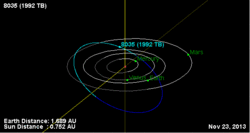astro.wikisort.org - Asteroid
(8035) 1992 TB is an Apollo asteroid, a type of Near-Earth Object. It is also a Venus-crosser and a Mars-crosser, although it doesn't make close approaches to Mars.[5]
 Orbit of (8035) 1992 TB | |
| Discovery[1] | |
|---|---|
| Discovered by | Spacewatch |
| Discovery site | Kitt Peak Observatory |
| Discovery date | 2 October 1992 |
| Designations | |
Alternative designations | None |
| Orbital characteristics[1][2] | |
| Epoch 13 January 2016 (JD 2457400.5) | |
| Uncertainty parameter 0 | |
| Observation arc | 8363 days (22.90 yr) |
| Aphelion | 1.9625 AU (293.59 Gm) |
| Perihelion | 0.72149 AU (107.933 Gm) |
Semi-major axis | 1.3420 AU (200.76 Gm) |
| Eccentricity | 0.46238 |
Orbital period (sidereal) | 1.55 yr (567.83 d) |
Mean anomaly | 145.13° |
Mean motion | 0° 38m 2.364s / day |
| Inclination | 28.308° |
Longitude of ascending node | 185.64° |
Argument of perihelion | 6.0430° |
| Earth MOID | 0.273002 AU (40.8405 Gm) |
| Jupiter MOID | 2.99532 AU (448.093 Gm) |
| Proper orbital elements | |
Proper eccentricity | 0.5068[3] |
Proper inclination | 24.45°[3] |
Proper mean motion | 231.32 deg / yr |
Proper orbital period | 1.55629 yr (568.433 d) |
| Physical characteristics | |
| Dimensions | 1.673 km (1.040 mi).[4][lower-alpha 1] |
Absolute magnitude (H) | 17.1 |
Encounters with Venus and Earth
1992 TB makes close approaches to Earth, but often comes many times closer to Venus. Soon after the discovery of the asteroid in 1992, a close approaches of Earth was made. Three years after it was discovered, 1992 TB came 45,720,000 km (0.3056 AU) from Earth.[1] In 2003, (8035) 1992 TB was listed as a potentially hazardous object,[6] but has since been removed. However, 1992 TB is not expected to come within 37,000,000 km (0.25 AU) of Earth in the near future.[1] On the other hand, 1992 TB can come much closer to Venus. Its next Venus encounter was in 29 May 2015, where it came 11,710,000 km (0.0783 AU) from the planet.[5] Its closest approach in the near future will be 7,380,000 km (0.0493 AU).[1]
Notes
- Assuming an albedo of 0.1
References
- "(8035) 1992 TB". JPL Small-Body Database. Jet Propulsion Laboratory. SPK-ID: 2008035. Retrieved 4 April 2016.
- "Comets and Asteroids: 8035 (1992 TB)". Find the Data. 11 November 2013. Retrieved 21 November 2013.
- "(8035) 1992TB". Neodys. University of Pisa. Retrieved 23 November 2015.
- "Conversion of Absolute Magnitude to Diameter for Minor Planets". Sephen F. Austin State University. Dan Burton. Archived from the original on 23 March 2010. Retrieved 26 November 2013.
- "Upcoming Close Approaches (< 0.10 AU) of NEOs to the Inner Planets". Shaw. Retrieved 19 November 2013.
- "MPEC 2003-V26 : PHAS (2003 NOV. 27.0 TT)". International Astronomical Union. Minor Planet Center. 27 November 2003. Retrieved 21 November 2013.
External links
- (8035) 1992 TB at NeoDyS-2, Near Earth Objects—Dynamic Site
- Ephemeris · Obs prediction · Orbital info · MOID · Proper elements · Obs info · Close · Physical info · NEOCC
- (8035) 1992 TB at ESA–space situational awareness
- (8035) 1992 TB at the JPL Small-Body Database
Другой контент может иметь иную лицензию. Перед использованием материалов сайта WikiSort.org внимательно изучите правила лицензирования конкретных элементов наполнения сайта.
WikiSort.org - проект по пересортировке и дополнению контента Википедии